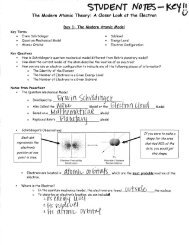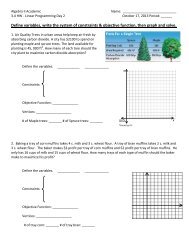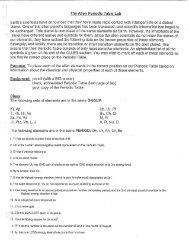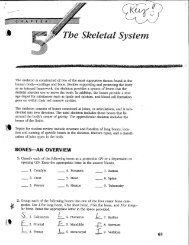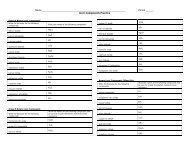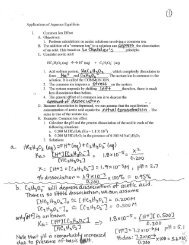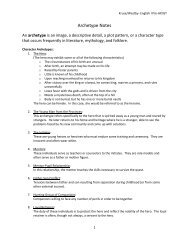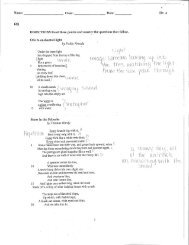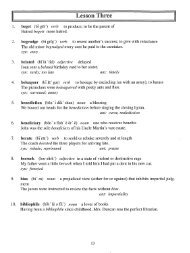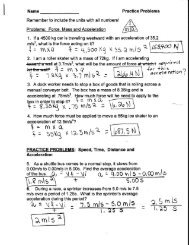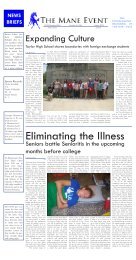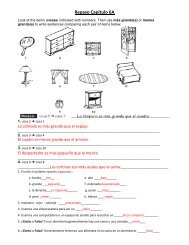I Answer: H. 0 x \ 0-' я O
I Answer: H. 0 x \ 0-' я O
I Answer: H. 0 x \ 0-' я O
Create successful ePaper yourself
Turn your PDF publications into a flip-book with our unique Google optimized e-Paper software.
[<br />
f<br />
J<br />
.) Exercise 1:<br />
oÿ¢; 3,0<br />
Exercise 2:<br />
Practice Exercises<br />
When sugar is poured from the box into the sugar bowl, the rubbing of sugar<br />
grains creates a static electric charge that repels the grains, and causes sugar<br />
to go flying out in all directions. If each of two sugar grains acquires a charge<br />
of 3.0 × 10-11 C at a separation of 8.0 × 10-ÿ m, with what force will they<br />
repel each other?<br />
q ÿ l Dÿ ÿJ ÿ.[c ÿ-<br />
<strong>Answer</strong>: 1,3)4 1 0"-ÿ ÿ]<br />
Boppo the clown carries two mylar balloons that rub against a cÿus elephant,<br />
causing the balloons to separate. Each balloon acquires 2.0 × 10- C of charge.<br />
How large is the electric force between them when they are separated by a<br />
distance of 0.50 m?<br />
Exercise 3: Inez uses hairspray on her hair each morning before going to school. The.<br />
spray spreads out before reaching her hair partly because of the electrostatic<br />
charge on the hairspray droplets. If two drops of hairspray repel each other<br />
with a force of 9.0 X 10-9 N at a distance of 0.070 cm, what is the charge on<br />
each of the e uÿy-charged drops of hairspray?<br />
F= Ol,O xxO-qN ;$<br />
I <strong>Answer</strong>: H. 0 x \ 0-' ÿ O<br />
:ÿ q.x 1O-"ÿa<br />
Electrostatics 199<br />
-t3 ¢
Exercise 4:<br />
Bonnie is dusting the house and raises a cloud of dust particles as she wipes<br />
across a table. If two 4.0 x 10-14-C pieces of dust exert an electrostatic force of :ii<br />
2.0 × 10-12 N on each other, how far apart are the dust particles at that time?<br />
Exercise 5: Each of two hot-air balloons acquires a charge of 3.0 × 10-5 C on its surface<br />
as it travels through the air. How far apart are the balloons if the electrostatic<br />
force between them is 8.1 x 10ÿ2 N?<br />
Cbÿ s,oÿ-s< Kÿqÿ toÿ ÿicÿ ÿ ÿL
Name:<br />
Electrostatics<br />
Chapter 17.1 Questions<br />
1. When a rubber rod is rubbed with wool, the rod becomes negatively charged. What can you conclude<br />
about the magnitude of the wool's charge after the rubbing process?<br />
Date:<br />
, If you stick a piece of transparent tape on your desk and then quickly pull it off, you will find that the<br />
tape is attracted to other areas of your desk that are not charged. Why does this happen?<br />
3. Metals, such as copper and silver, can become charged by induction, while plastic materials cannot.<br />
Explain why?<br />
Chapter 17.2 Questions<br />
4. A balloon rubbed against a denim gains a charge of-8.0 x 10-6C. What is the electric force between the<br />
balloon and the denim when the two are separated by a distance of 5.0 cm?<br />
5. Two identical conducting spheres are placed with their centers 0.30 m apart. One is given a charge of<br />
+12 x 10-9 C and the other is given a charge of -'18 x 10-9 C.<br />
a. Find the electric force exerted on one sphere by the other.
6. A small cork with an excess charge of +6.0/ÿC is placed 0.12 m from another cork, which carries a charge of<br />
-4.3/ÿC.<br />
a. What is the magnitude of the electric force between the corks?<br />
b. Is this force attractive or repulsive?<br />
How many excess electrons are on the negative cork?<br />
.--- ÿ,-sÿlo-ÿ 6 x i t<br />
- I,ÿpÿ-/q 6<br />
'ÿdÿ How many electrons has the positive cork lost?<br />
7. Two electrostatic point charges of +60.O/JC and +50/ÿC exert a repulsive force on each other of 175 N. What<br />
is the distance between the two charges?<br />
@/- ÿo,oxto-@ ¢<br />
q?, ÿ t-o,o Ylt-ÿo<br />
Fÿ9 #<br />
o @ ox o (&o,oxlo-<br />
I1.ÿ- 1"7S
t<br />
,<br />
.<br />
,<br />
,<br />
.<br />
.<br />
,<br />
,<br />
Electric Charge and Force Skills Sheet<br />
Prepare these numbers for calculations by putting them into standard units:<br />
A. 15gC B. 4.9nm ÿ C. 8MHz D. 6mm<br />
15xlO-6C q, ÿ ,,ÿ ÿ° r¢l ÿ/X,/0 ÿiÿ"2, ÿ ÿ/0-ÿ<br />
How much charge does 1,200 electrons have?<br />
An object has a charge of 2.4 gC.<br />
A. Is it ÿ!or negative?<br />
B. Did it gain or(Iÿoseÿlectrons?<br />
C. How many eleÿons were gained or lost?<br />
How many electrons were gained or lost by a 4.5 milliC charge?<br />
= IMx Izÿÿ3<br />
Possible or impossible:<br />
A. 12 electrons B. 15.5 electron C. 6.3 electrons<br />
• -, Od,ÿ ha<br />
A 3 C charge is 4 mm away from a 6 C charge.<br />
Find the force between them.<br />
oO.m<br />
A 7.2 gC charge is 20 cm away from a 3.8 gC charge. Find the force.<br />
How does the electric force change?<br />
A. If one of the charges is tripled?, 77ire_e_ ÿ-ÿ ÿ5 ÿ ÿ-<br />
B. If the distance doubles? )/q<br />
C. If one of the charges is halved? F/ÿ<br />
D. It'the distance is halved? ÿ/C"<br />
Two electric forces are acting on a positive charge, as seen at the right.<br />
A. Using the ideas of attraction and repulsion, decide whether the two<br />
blank charges are positive or negative.<br />
B.<br />
C°<br />
D°<br />
do<br />
E. 7 centicoulombs<br />
Calculate the net force on the charge (including magnitude and direction). II<br />



